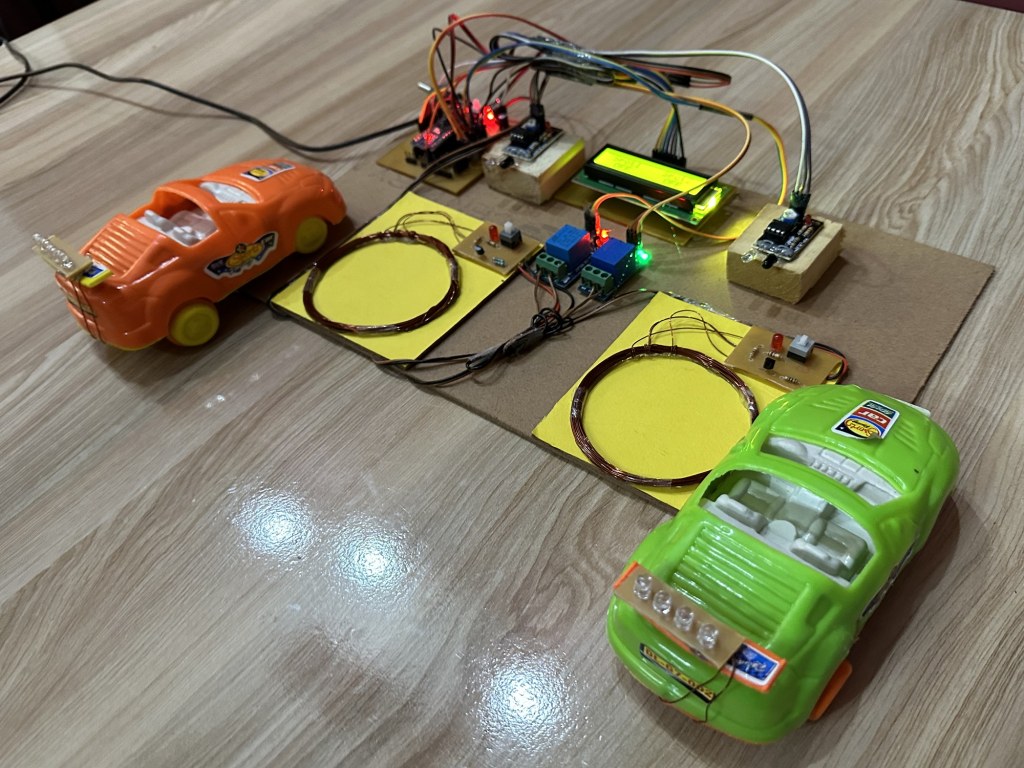Revolutionizing Energy Efficiency: The Ultimate Wireless Electric Vehicle Charging Project Report – Uncover The Future Of Transportation!
Wireless Electric Vehicle Charging Project Report
Hello Smart Readers,
Welcome to this comprehensive report on the wireless electric vehicle charging project. In this article, we will explore the latest advancements in wireless charging technology for electric vehicles and its impact on the transportation industry. So, let’s dive in and discover how this innovative solution is shaping the future of electric mobility.
3 Picture Gallery: Revolutionizing Energy Efficiency: The Ultimate Wireless Electric Vehicle Charging Project Report – Uncover The Future Of Transportation!
Introduction
Electric vehicles (EVs) have gained significant popularity in recent years due to their environmental benefits and cost-effectiveness. However, one of the major challenges faced by EV owners is the hassle of plugging in their vehicles for charging. To overcome this issue, researchers and engineers have developed wireless electric vehicle charging systems.
Wireless electric vehicle charging, also known as inductive charging, enables EVs to charge without the need for physical connections. This technology utilizes electromagnetic fields to transfer energy between a charging pad or coil installed on the ground and a receiver coil in the vehicle. The process is efficient, convenient, and eliminates the need for manual plugging, making it a game-changer for the future of electric transportation.

Image Source: ytimg.com
In this project report, we will delve into the various aspects of wireless electric vehicle charging, including its purpose, key stakeholders involved, timeline, locations, reasons behind its development, and the technology’s working mechanism.
What is Wireless Electric Vehicle Charging?
Wireless electric vehicle charging is a revolutionary technology that allows electric vehicles to charge their batteries without the need for physical connections. It uses electromagnetic fields to transfer energy from a ground-based charging pad or coil to a receiver coil installed in the vehicle, eliminating the need for manual plugging.
This technology is based on the principle of electromagnetic induction, where an alternating current is passed through a charging pad or coil, creating a magnetic field. When an EV is parked on top of the charging pad, the receiver coil in the vehicle captures the magnetic field and converts it back into electrical energy to charge the battery.
Wireless electric vehicle charging offers several advantages over traditional wired charging methods. It eliminates the need for tangled cables, reduces wear and tear on charging ports, and provides a seamless charging experience for EV owners.
Advantages of Wireless Electric Vehicle Charging:

Image Source: srrobotics.in
1. Convenience: Wireless charging eliminates the need for manual plugging, making it more convenient for EV owners to charge their vehicles.
2. Safety: The absence of physical connections reduces the risk of electrical hazards and potential damage to the charging equipment.

Image Source: rgstatic.net
3. Efficiency: Wireless charging systems are designed to be highly efficient, minimizing energy losses during the charging process.
4. Scalability: Wireless charging infrastructure can be easily scaled up to accommodate a growing number of electric vehicles.
5. Future-Proofing: As wireless charging technology continues to evolve, it ensures compatibility with future EV models and advancements.
Disadvantages of Wireless Electric Vehicle Charging:
1. Cost: Wireless charging systems are currently more expensive to install compared to traditional wired charging stations.
2. Efficiency Loss: Wireless charging is slightly less efficient than wired charging, leading to longer charging times.
3. Alignment: Proper alignment between the charging pad and the receiver coil is crucial for efficient charging, which may require driver assistance.
4. Power Limitations: Wireless charging may have limitations on the power output, leading to slower charging rates for high-capacity batteries.
5. Infrastructure Deployment: The widespread adoption of wireless charging requires significant infrastructure deployment, which may take time.
Who is Involved in the Wireless Electric Vehicle Charging Project?
The development and implementation of wireless electric vehicle charging involve various stakeholders, including:
1. Electric Vehicle Manufacturers: Automakers play a crucial role in integrating wireless charging capabilities into their electric vehicle models.
2. Technology Companies: Companies specializing in wireless charging technologies develop the necessary equipment and infrastructure.
3. Energy Providers: Collaboration with energy providers is essential to ensure a smooth integration of wireless charging systems with the power grid.
4. Governments and Regulatory Bodies: Governments and regulatory bodies work towards setting standards and regulations for wireless charging technology.
5. Research Institutions: Research institutions contribute to the advancement of wireless charging technology through research and development.
6. Infrastructure Providers: Companies involved in infrastructure development play a vital role in deploying wireless charging stations at various locations.
When and Where Does the Wireless Electric Vehicle Charging Project Take Place?
The wireless electric vehicle charging project has been under development for several years, with ongoing research and pilot projects in various countries. Major cities and urban areas are the primary focus for the deployment of wireless charging infrastructure, as they have a higher concentration of electric vehicles.
Leading countries in the wireless electric vehicle charging project include the United States, Germany, the United Kingdom, China, and Japan. These countries have made significant investments in research, development, and infrastructure deployment to promote the adoption of wireless charging technology.
Why is the Wireless Electric Vehicle Charging Project Necessary?
The wireless electric vehicle charging project is essential for several reasons:
1. Convenience: Wireless charging eliminates the need for manual plugging, providing a more convenient charging experience for electric vehicle owners.
2. Adoption Boost: The availability of wireless charging infrastructure can encourage more people to switch to electric vehicles.
3. Future-Proofing: As wireless charging technology continues to evolve, it ensures compatibility with future electric vehicle models and advancements.
4. Environmental Benefits: Widespread adoption of electric vehicles powered by renewable energy sources can significantly reduce carbon emissions and combat climate change.
5. Technology Advancement: The wireless electric vehicle charging project drives technological advancements in the field, benefiting the overall transportation industry.
How Does Wireless Electric Vehicle Charging Work?
Wireless electric vehicle charging works through the principle of electromagnetic induction. Here’s a step-by-step explanation:
1. The charging pad or coil is installed on the ground, connected to a power source, and generates an alternating current.
2. An electromagnetic field is created around the charging pad when the alternating current flows through it.
3. An electric vehicle equipped with a receiver coil parks on top of the charging pad.
4. The receiver coil in the vehicle captures the magnetic field and converts it back into electrical energy.
5. The converted electrical energy charges the vehicle’s battery, providing power for the electric motor.
6. Once the battery reaches its desired charge level or the charging process is complete, the charging stops automatically.
Frequently Asked Questions (FAQs)
1. Is wireless electric vehicle charging safe?
Yes, wireless electric vehicle charging is safe. The technology undergoes rigorous testing and complies with safety standards to ensure the protection of users and their vehicles.
2. How efficient is wireless electric vehicle charging?
Wireless electric vehicle charging is designed to be highly efficient, with energy transfer rates comparable to traditional wired charging methods.
3. Can any electric vehicle be charged wirelessly?
Wireless charging is compatible with most electric vehicle models, but certain requirements, such as installing a receiver coil, need to be met for wireless charging capability.
4. How long does it take to charge an electric vehicle wirelessly?
The charging time for wireless electric vehicle charging depends on various factors, including the vehicle’s battery capacity, charging infrastructure’s power output, and overall efficiency. Generally, it may take slightly longer than traditional wired charging.
5. Are wireless charging stations widely available?
While wireless charging stations are not as prevalent as traditional charging stations, their deployment is steadily increasing. Major cities and urban areas are leading the way in installing wireless charging infrastructure.
Conclusion
In conclusion, the wireless electric vehicle charging project is revolutionizing the way electric vehicles are charged. With its convenience, safety, and scalability, wireless charging offers a promising solution to address the challenges of traditional wired charging methods. As technology continues to advance and infrastructure deployment expands, wireless charging will play a significant role in the widespread adoption of electric vehicles and the transformation of the transportation industry.
It is now up to governments, automakers, technology companies, and energy providers to collaborate and invest in the wireless electric vehicle charging project. By doing so, we can create a sustainable and efficient future for electric mobility.
Final Remarks
This article provides a comprehensive overview of the wireless electric vehicle charging project, highlighting its benefits, challenges, and potential impact. As technology evolves and infrastructure deployment accelerates, wireless charging will become an integral part of our daily lives, shaping the future of transportation.
Disclaimer: The information presented in this report is based on current knowledge and research. The wireless electric vehicle charging project is a dynamic field, subject to ongoing developments and advancements.
This post topic: Electric



